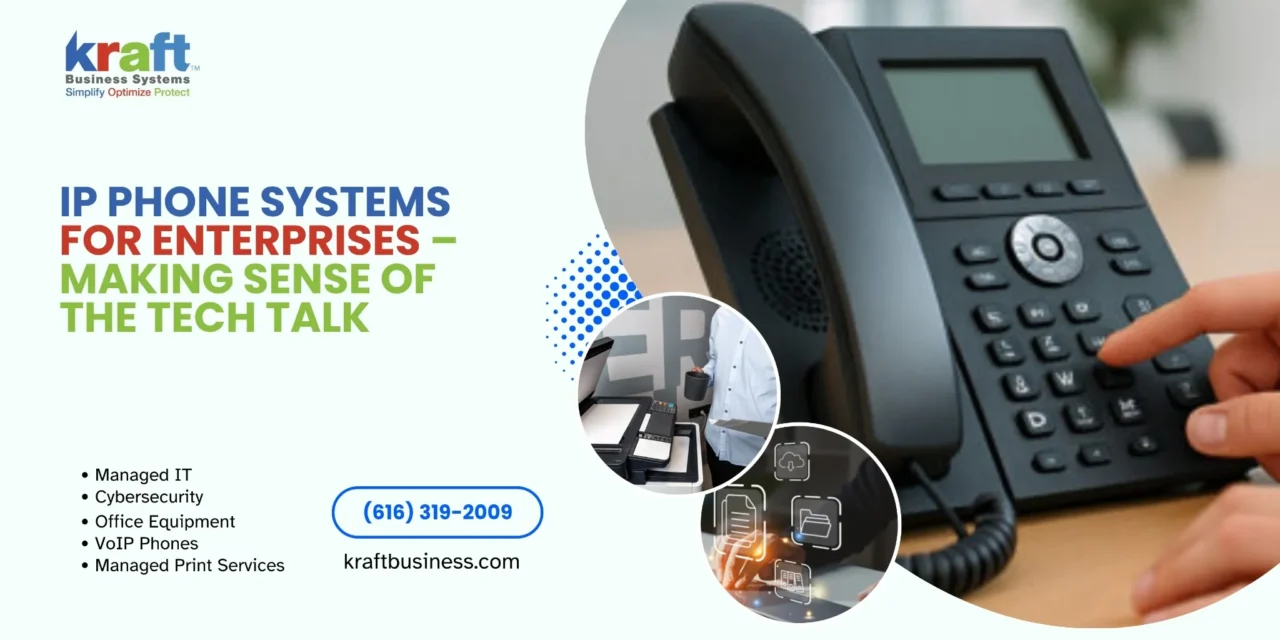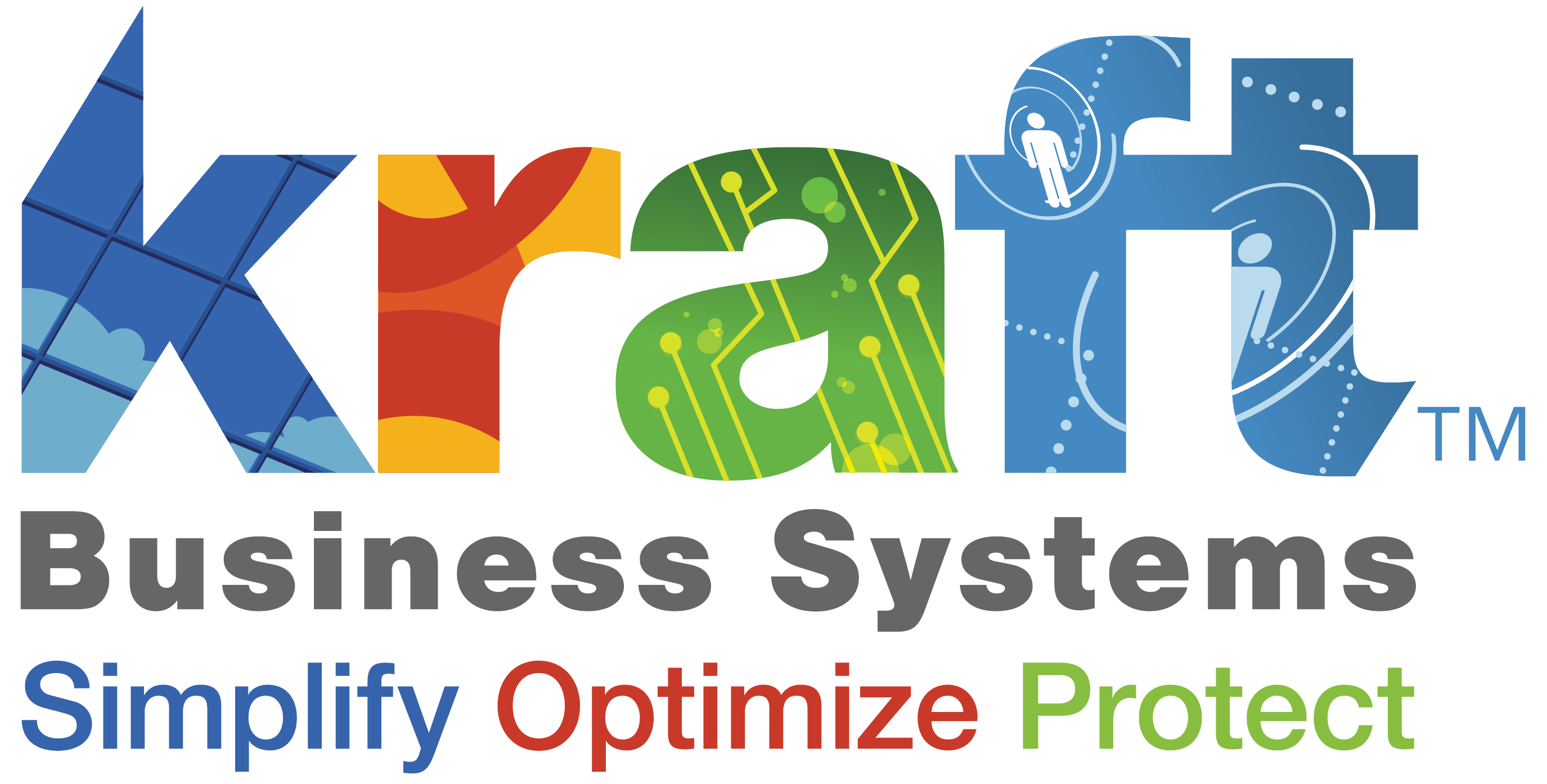Enterprise IP phone systems are changing business communications by leveraging internet protocols to deliver voice, video, and messaging services with improved features and significant cost savings.
For busy decision-makers, here’s what you need to know:
| Key Aspect | What It Means For Your Business |
|---|---|
| Technology | Uses internet protocols (VoIP) instead of traditional phone lines |
| Cost Savings | Can reduce telecom expenses by up to 80% compared to legacy systems |
| Flexibility | Supports remote work with identical features anywhere |
| Scalability | Add or remove users without physical hardware changes |
| Integration | Connects with CRM, Microsoft 365, and other business tools |
| Features | HD audio, video conferencing, call analytics, and AI capabilities |
These systems have evolved from simple voice-over-internet solutions to comprehensive unified communications platforms offering everything from basic telephony to advanced features like AI-powered transcription and seamless business application integration.
“Switching to VoIP can cut licensing costs by up to 80% compared to traditional phone systems,” notes industry research, making these systems particularly attractive for mid-sized businesses looking to optimize IT budgets.
For organizations with distributed teams, these systems eliminate geographic barriers. Your Michigan headquarters and California branch can share the same phone system with identical features and a unified dial plan.
What makes enterprise IP systems different from consumer VoIP services is their reliability, security, and enterprise-grade features designed to handle high call volumes while maintaining crystal-clear quality.
Simple enterprise ip phone systems word guide:
What Are Enterprise IP Phone Systems?
Enterprise IP phone systems are the heartbeat of modern business communication—powerful platforms that send voice calls as digital data over the internet instead of traditional copper phone lines.
Unlike simple VoIP services you might use at home, enterprise ip phone systems are built for the big leagues, delivering traditional PBX features through sophisticated software rather than expensive hardware.
These systems rely on Session Initiation Protocol (SIP)—the digital handshake that sets up calls and manages them from hello to goodbye. SIP trunking replaces bulky telephone trunks with virtual connections over the internet, letting you keep familiar phone numbers while trimming your monthly phone bill.
As we explain in our guide on Everything You Need to Know About Voice Over Internet Protocol, these systems deliver crisp, HD audio that often sounds better than traditional phone lines.
| Traditional PBX | Enterprise IP Phone System |
|---|---|
| Dedicated hardware | Software-based or cloud-hosted |
| Physical phone lines | Internet connection |
| Limited scalability | Add users with software licenses |
| Location-dependent | Location-independent |
| High capital expense | Subscription-based pricing |
| Limited remote capabilities | Full features anywhere |
| Basic calling features | Advanced unified communications |
How enterprise ip phone systems differ from legacy lines
The magic happens in how they handle your voice. Traditional phones create a dedicated circuit for each call—like reserving a private highway lane. IP systems break your voice into tiny data packets that zip through the internet alongside emails, then reassemble perfectly at the other end.
This packet-based approach means big savings through concurrent call licensing. Since not everyone is on the phone simultaneously, you might need only 30 licenses for a 100-person company—cutting phone costs by up to 80%.
The PBX transforms from expensive hardware into flexible software running on standard servers or in the cloud, eliminating costly maintenance contracts for specialized equipment.
Perhaps best of all, your phone extension follows you anywhere. Remote workers, traveling executives, and home-based staff all connect to the same system with identical features.
Core components of enterprise ip phone systems
A complete enterprise ip phone system brings together several key elements:
IP Phones sit on desks throughout your office—sleek devices designed specifically for VoIP, ranging from basic models to executive phones with colorful touchscreens.
Softphones turn ordinary devices into business phones. That laptop in your home office or your smartphone becomes a full-featured extension with the right software.
Gateways are the translators between your modern IP system and older technology, letting you keep using analog devices like fax machines.
Session Border Controllers stand guard at the edge of your voice network, protecting calls from security threats while ensuring quality connections.
Quality of Service Tools prioritize voice packets so your conversations flow naturally without delays or dropouts.
Management Platforms give your IT team user-friendly dashboards to configure the system and monitor performance without needing a telecommunications degree.
Key Benefits for Large Organizations
Switching to enterprise ip phone systems isn’t just a tech upgrade—it’s a complete change in how your organization communicates, with benefits extending far beyond cost savings.
With these systems, team members working from home, client sites, or satellite offices are all connected to the same powerful communication platform, regardless of location—an essential capability for modern businesses.
Financial upside & ROI
The financial advantages are compelling enough to make even the most conservative CFO take notice.
Most organizations see telecom expenses drop by up to 80% after switching from traditional systems. This reduction comes from paying less for long-distance calls, eliminating separate voice and data networks, and ending costly maintenance contracts.
The subscription model transforms how you budget for communications. Rather than large upfront investments in depreciating hardware, you’ll have predictable monthly expenses classified as operating costs.
Hardware costs shrink significantly too. With softphone applications, physical desk phones become optional. When you do need physical phones, they connect to your existing network—no separate wiring required.
As we explain in our Cloud-Based Enterprise Phone Systems guide, most organizations see positive ROI within the first year. Our Michigan clients particularly appreciate how these systems handle harsh winters—when staff can’t make it to the office, their business phone system travels with them.
Collaboration superpowers
Modern enterprise ip phone systems transform team collaboration as comprehensive platforms that unify all communication channels.
With unified communications, everything lives in one place—voice, video, messaging, presence information, and conferencing. Team members can seamlessly switch between channels based on what works best. Start with a chat, escalate to a call, add video, and share your screen—all without switching applications.
High-definition video meetings become as simple as making a phone call, with everyone joining with a click to experience high-quality video and crystal-clear audio.
Team chat keeps conversations flowing without the interruption of constant calls—perfect for quick questions or keeping project discussions in one searchable place.
CRM integration might be the most powerful productivity booster. When a customer calls, their information automatically appears on screen, creating more personalized service while saving valuable time.
Mobile capabilities mean your team can use their business phone numbers on personal devices, maintaining professional communication while preserving personal privacy.
Deployment Options: On-Premises, Cloud & Hybrid
When setting up an enterprise ip phone system, you’ve got three main paths: keep everything in-house with on-premises systems, move everything to the cloud, or blend the two approaches with a hybrid solution.
On-prem enterprise ip phone systems
With on-premises deployment, your phone system lives on servers within your building—giving you complete control.
Your IT team calls all the shots, from hardware choices to software configurations and security measures. This approach works wonderfully for organizations with unique requirements that off-the-shelf solutions might not address.
When the internet goes down, on-premises systems keep working. This local survivability means critical communications don’t stop when cloud connectivity fails—a non-negotiable feature for many Michigan businesses.
For organizations with strict regulations, on-premises deployment can simplify compliance by keeping all communication data within your walls.
Many on-premises solutions offer perpetual licensing rather than subscriptions, which can be financially advantageous for stable organizations.
The trade-off? You’ll need significant upfront investment in hardware and software, plus your IT team shoulders responsibility for maintenance and security. Our guide on IP PBX and SIP Trunking explains how SIP trunking can still help on-premises systems connect to the public telephone network at reduced costs.
Hosted enterprise ip phone systems
Cloud-based deployment moves your phone system to the provider’s data centers, delivering service over the internet—an increasingly popular approach for businesses of all sizes.
You’ll be up and running in days, not months. This rapid deployment means minimal on-site installation and faster time-to-value. One Michigan healthcare client transitioned 200+ users to a cloud system in just under a week.
The subscription model eliminates large upfront investments, shifting from capital expenses to operating expenses. Your provider handles all maintenance and updates automatically, ensuring you always have the latest features and security patches.
Need to add seasonal workers and remove them later? No problem. Cloud systems scale up or down instantly without hardware constraints—particularly valuable for businesses with fluctuating needs.
The main considerations include ongoing subscription costs, dependence on internet connectivity, and potential regulatory concerns. Our Cloud-Based VoIP resource explores how hosted solutions benefit organizations of all sizes.
Hybrid approaches
Many clients find that hybrid deployments offer the best of both worlds.
A popular approach keeps critical components on-site while running the core system in the cloud, maintaining local survivability for essential functions while reducing hardware footprint.
For businesses with multiple locations, you might deploy cloud services for smaller offices while maintaining on-premises systems at headquarters—balancing control and cost across your organization.
If you’ve already invested in on-premises equipment, hybrid models allow for gradual migration to cloud services, spreading costs over time and reducing disruption.
Implementation & Security Best Practices
Successful deployment of enterprise ip phone systems requires careful planning and attention to security to ensure smooth implementation and protect your communications.
Step-by-step rollout
Start with a thorough network assessment to ensure your existing network can handle voice traffic. Check bandwidth (roughly 100 kbps per simultaneous call), network latency (under 150ms), jitter (under 30ms), and packet loss (less than 1%).
Begin number porting preparation early in the process. Transferring existing phone numbers can take 2-4 weeks, so starting early prevents communication gaps.
Rather than diving into company-wide deployment, start with a pilot group of tech-savvy users who can help identify issues before everyone else comes onboard and become internal champions.
Configuring Quality of Service (QoS) is critical. Set up VLAN segmentation to give voice traffic its own network lane, tag voice packets for priority treatment, reserve bandwidth for calls, and implement traffic shaping to manage congestion.
Customize user training for different groups: basic users learn everyday calling features, power users master conference management and advanced tools, while administrators get deep training on system management.
Use a phased cutover approach, transitioning departments one at a time to allow for focused support and manageable troubleshooting.
Plan for improved post-implementation support during the first few weeks with quick-reference guides and dedicated help resources to improve adoption rates and user satisfaction.
Avoiding common pitfalls with enterprise ip phone systems
Insufficient bandwidth is perhaps the most frequent culprit behind poor call quality. Always build in headroom for growth and peak usage periods.
Many organizations implement systems without proper Quality of Service configuration, resulting in voice packets fighting with large file downloads or video streams and causing choppy calls.
Weak security practices can leave your phone system vulnerable to toll fraud, eavesdropping, denial of service attacks, and account hijacking.
Inadequate redundancy planning can lead to complete communication blackouts during internet outages. Implement backup connections, failover systems, and consider keeping analog lines for emergencies.
Poor user adoption often stems from insufficient training and communication, leading to frustration and reversion to old habits like using personal cell phones.
Protect your system with encryption (TLS for signaling and SRTP for media), deploy Session Border Controllers, require strong authentication, keep all components updated with security patches, isolate voice traffic using network segmentation, and implement call monitoring to detect unusual patterns that might indicate fraud.
Ensuring Quality, Scalability & Integrations
For enterprise ip phone systems to truly shine, they need to deliver crystal-clear calls, grow alongside your business, and integrate with your other tools.
Quality assurance
Real-time monitoring dashboards give you a window into your system’s health, tracking everything from call quality scores to technical metrics like latency and packet loss.
Setting clear SLA targets gives everyone expectations to aim for. The gold standard is “five nines” (99.999%) uptime, which translates to less than six minutes of downtime per year.
Bandwidth management ensures call clarity by allocating sufficient resources. Each voice call needs about 100 kbps, while video calls require 1-2 Mbps per HD stream.
Proactive testing catches issues before they impact users. Regular network path testing, latency checks, and off-hours load testing can identify potential bottlenecks early.
Scalability considerations
Auto-scaling capabilities allow resources to flex during busy periods without manual intervention—like having extra lanes that automatically open during rush hour.
Regular capacity planning helps you stay ahead of growth by reviewing usage patterns and aligning them with business forecasts.
Your geographic expansion strategy should include local numbers in new markets, regional connection points for optimal quality, and consistent features regardless of location.
Streamlining user onboarding with automated provisioning, template-based setups, and self-service portals saves tremendous time as you grow.
Integration capabilities
Microsoft 365 integration brings communications and productivity tools together, allowing you to click a phone number in Outlook to start a call or sync your Teams presence status.
For organizations using Google Workspace, similar integrations sync contacts, calendar, and more between systems.
CRM integration connects your phone system with customer data, automatically displaying client information when they call, logging calls without manual entry, and enabling one-click dialing from customer records.
Help desk integration streamlines support operations by automatically creating tickets from calls, routing based on existing ticket status, and providing agents with the caller’s complete history.
For specialized needs, open APIs allow custom connections to unique business applications or in-house systems.
Future-proofing enterprise ip phone systems
AI transcription and analytics are changing how businesses understand conversations through automatic transcripts with sentiment analysis, keyword spotting, and compliance monitoring.
WebRTC integration eliminates barriers between browsers and communication systems, enabling click-to-call from websites and video consultations without downloads.
As 5G and edge computing mature, they’ll enable better mobile voice quality, lower latency, and new use cases combining voice with IoT and augmented reality.
Advanced mobile integration will soon offer seamless handoffs between networks, sophisticated noise suppression, and context-aware features that adapt based on location.
Frequently Asked Questions about Enterprise IP Phone Systems
What is SIP trunking and why does it matter?
SIP trunking creates virtual connections over the internet instead of physical copper wires connecting your office to the phone company.
This technology typically delivers 40-60% cost savings compared to traditional phone lines. You only pay for what you need—no more maintaining expensive lines that sit idle most of the time.
Enterprise ip phone systems with SIP trunking offer remarkable flexibility. Need more lines during your busy season? They can be added instantly. Business slowing down? Scale back without penalty.
One of the best benefits for Michigan clients is geographic freedom. SIP trunking lets you maintain local phone numbers from virtually anywhere, giving your business a “local presence” regardless of physical location.
When disaster strikes, calls can automatically reroute to alternate locations or mobile devices, keeping your business running even if your main office loses power or internet connectivity.
How can we guarantee 99.999% call uptime?
Achieving “five nines” reliability (just 5.26 minutes of downtime per year) requires thoughtful planning and layered redundancy.
Implement redundant internet connections from different providers that follow physically different paths to your building so a single incident can’t take down both lines.
Ensure power protection through uninterruptible power supplies (UPS) and generators to keep communication systems running during outages.
For cloud-based systems, choose providers with multiple data centers and automatic failover capabilities to maintain service during regional outages.
Consider local survivability options that maintain basic calling capabilities even when cloud connectivity is completely lost.
Implement mobile fallback to automatically forward calls to mobile devices during system outages.
Use proactive monitoring and conduct regular testing to identify potential issues before they cause outages and verify failover systems work as expected.
What budget should we plan for hardware, licenses, and bandwidth?
Quality desk phones range from basic models around $100 to executive devices with touchscreens in the $400+ range. Many organizations now mix approaches—providing desk phones for office staff while equipping remote workers with professional headsets ($80-200) for softphone applications.
Evaluate your network infrastructure for potential switch upgrades to support Power over Ethernet (PoE) and Quality of Service features. If keeping analog devices like fax machines, budget for appropriate gateways.
Cloud systems typically charge monthly per-user fees that include most features. On-premises systems often offer concurrent call licensing, which can reduce costs since not everyone makes calls simultaneously. A 100-person organization might need only 30 concurrent licenses.
For bandwidth, plan for approximately 100 kbps per simultaneous call, with video conferencing requiring 1-2 Mbps per HD stream.
Don’t overlook professional implementation and training costs. Even the best system will disappoint if poorly configured or if your team doesn’t know how to use its features.
Conclusion
Enterprise IP phone systems have transformed from simple cost-cutting alternatives into powerful communication hubs that genuinely change how organizations connect and collaborate.
These systems deliver game-changing benefits:
- Dramatic cost savings compared to traditional phone systems
- Location flexibility that enables work from anywhere
- Advanced features that boost productivity and customer satisfaction
- Seamless integration with existing business tools
- Scalability that accommodates growth without hardware overhauls
Whether an on-premises system, cloud solution, or hybrid approach makes sense depends on your specific requirements around control, compliance, and existing technology.
As your Michigan partner for secure, scalable communications, Kraft Business Systems brings the expertise to guide these choices and implement solutions custom to your organization. Our team serves businesses across the entire state—from Detroit and Grand Rapids to Traverse City and beyond.
We understand that communication isn’t just another business function—it’s the heartbeat of your organization. Whether you’re replacing an aging system or adding new capabilities, we provide the support to ensure a smooth transition.
Looking ahead, enterprise communications will continue evolving with AI-powered insights, deeper application integration, and new collaboration methods. By choosing a flexible, standards-based system today, you position your organization to adopt these innovations as they mature.
Ready to see how an enterprise ip phone system could transform your organization? Reach out to Kraft Business Systems to discuss your unique needs and develop a practical roadmap for unified, efficient communications. Our Business Hosted Voice solutions provide the solid foundation your organization needs to communicate effectively today and tomorrow.














